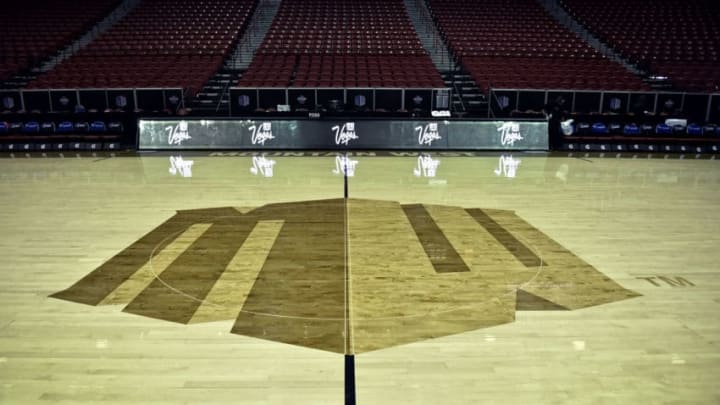Mountain West Basketball is hoping for another season with multiple teams in the Big Dance. What are the odds for the 2019-20 campaign?
Mountain West Basketball is fresh off a season that saw two of its teams make the NCAA Tournament. Nevada, a preseason Final 4 favorite, struggled down the stretch and made the field as a #7 seed, falling to Florida in the First Round. Utah State, a surprising regular-season and tournament champion, earned an #8 seed, before exiting in the First Round against Washington. All in all, the Mountain West Conference was indeed a ‘multi-bid league’ last season. But what does it look like for the immediate future?
First, let’s take a look at recent years for the conference. In the early 2010s, the league began to regularly send multiple teams to the NCAA Tournament. This came to a head in 2013 when the Mountain West sent five (yes, five) teams to the tournament – Each of these teams boasting a Top-50 RPI ranking on ESPN at the time; led by a New Mexico team holding a #2 RPI ranking. In the years since, however, the conference has struggled in sending representatives to the dance: Here’s a list of Mountain West teams that made the tournament each year, with their respective regional seed in parentheses.
2014: San Diego State (#4), New Mexico (#7)
2015: San Diego State (#8), Boise State (#11), and Wyoming (#12)
2016: Fresno State (#14)
2017: Nevada (#12)
2018: Nevada (#7), San Diego State (#11)
2019: Nevada (#7), Utah State (#8)
Notice the sharp decrease in not just fielded teams, but in seed ranking, especially after the 2015 season. There has been a lot of speculation as to why this is. Some blame strength of schedule for the conference as a whole, flagship programs experiencing ‘down’ seasons, or even the fact that it is increasingly difficult for mid-major teams to make the NCAA Tournament in the modern college basketball landscape. There are several factors – one of note being conference realignment.
With realignment in mind, let’s take a look at where the Mountain West stands right now. First, the league returns a wealth of talent, making for a number of teams that could contend for tourney bids. Going along with what is arguably the deepest pool of coaches the Mountain West has seen in some time, this makes for a ton of potential (More on that in a bit.) Second, programs that are newer to the conference are catching up. Exemplifying this, one can look to the amount of success the Nevada Wolf Pack has had in recent seasons (conference titles, Sweet 16 in 2018, national hype in 2019). This is great but takes me to my main point.
With some of the conference’s bigger names (UNLV, San Diego State, New Mexico) still experiencing rebuilds of different levels, the national perception of the Mountain West is not what it once was. This matters most when it comes to how the league schedules in non-conference play. Again, take Nevada last season – The Pack had three wins over Pac-12 squads in non-conference play, highlighted by an Arizona State team that was nationally ranked at the time. Yet, Nevada could not account for a weaker Pac-12 conference in general, making those same three wins much less impressive in the eyes of the committee, come selection time for the NCAA Tournament bracket. Scheduling is perhaps the most crucial factor in this equation.
Glancing at the talent and coaching a little more deeply, a few teams come into play for this tournament bid conversation. The star team of next season is, of course, Utah State, returning most of their lineup from last year’s surprise season, including MWC Player of the Year Sam Merrill, and breakout rising-sophomore Neemias Queta. San Diego State maintains a talented roster, despite losing production to both graduation and the NBA Draft. Transfer guards Malachi Flynn (Washington State) and KJ Feagin (Santa Clara) are primed for big roles in the post-Jalen McDaniels era.
New Mexico has arguably the most talented roster in the league (Even with star shooter Anthony Mathis’ departure to Oregon), while Nevada and Boise State are deeper than many believe; Leon Rice (Boise State) and Steve Alford (Nevada) bring experience, confidence, and composure to their respective programs, and any growing pains would likely be dealt with quickly in the season. Look for these teams to contend for not just the conference title, but tournament bids in 2020.
The Mountain West might be operating under the national radar as of now, but there is plenty to be excited about. Potential exists even in teams that are staring at rebuilds, such as UNLV. Chemistry will be key to on-court performance for many teams (New Mexico), and the 2019-20 season is shaping up to be a very unpredictable one for the conference… Will it be a ‘multi-bid league’? While some may have given up on the conference, it seems to be well on its way to reclaiming a consistent multi-bid status. However, that remains to be seen on the court.
